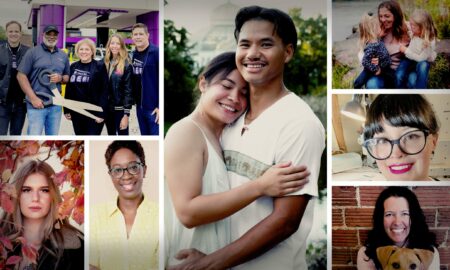

Today we’d like to introduce you to Larry Hill.
Hi Larry, I’m so excited to have you on the platform. So before we get into questions about your work life, how can you bring our readers up to speed on your story? How did you get to where you are today?
It was a beautiful day at the Minnesota State Fair in 2003. My wife Arlene and I were visiting the bee exhibit in the horticulture building. There was a large screened-in room with 10’s of thousands of honeybees inside. I started talking with a man, Roger Olsen, who was as fascinated with the bees as I was that day. I quickly learned he was a beekeeper and part of the MN Honey Producers Association. I thanked him for his time, and as we walked away, Arlene suggested I get a honeybee colony because I couldn’t stop smiling. Initially, I hesitated because I didn’t want to get stung and knew nothing about raising honeybees.
Shortly after, I spoke to my next-door neighbor, Peter, and asked if he minded if I could place a beehive on our property line. He said he always wanted bees and suggested we each get one and we would put them along his driveway. He also mentioned his cousin Alex Ernst, who was 84 years old and had been a beekeeper since he was 13, and Alex would be happy to teach us what we needed to know.
In the spring of 2004, Pete and I each bought the equipment needed for two colonies of bees, along with a smoker and the book Beekeeping for Dummies. Then we ordered two boxes of bees with about 10,0000 bees in each box plus a queen. We followed the instructions to place the bees in the hive and became beekeepers. I was still working on this new hobby because I didn’t invest in a bee suit or veil. So when we opened the hives, we smoked the hell out of them so they wouldn’t sting us. Moving slowly and deliberately was the best advice to keep the bees calm. All was going well until I dropped a frame on top of an open hive, and it got ugly fast. I couldn’t run away fast enough, getting stung multiple times. I returned hours later to close up the hive, and Alex worked our bees the rest of that year, including pulling our honey and extracting it for us. On Christmas Eve, as we returned from church, there were about 40 pounds of honey in a bucket, along with a bag of empty honey bear bottles on the porch left by Alex. We bottled our first honey on Christmas Day 2004 using a label and a transmission fluid funnel.
I was hooked and wanted to learn more. I signed up for a class on beekeeping at the University of Minnesota. I purchased a bee suit and wanted two more hives. Another neighbor, Brian, wanted to be a beekeeper, so he also got two colonies. That was a fun year, and we learned a lot. While enjoying some of Pete’s homemade wine, we discussed starting a honey business. So, I began assembling a business plan to purchase the equipment needed to extract and expand our colonies to 25 next year. I told Peter and Brian if we each invested $5,000, that would be a good start, and then we would invest our profits into the business each year and grow our business. They both had busy lives and young families and said they would love to help me, but we won’t invest. I agreed; I would put up all the money and care for the bees. They both would help as they could and find locations for me to put the colonies. That year, we harvested nearly 700 pounds of honey, which I quickly sold to bakeries in Minneapolis for $1.50 per pound. But now I was trying to create a name for the business. We live on the corner of Ironwood and Aspen in Lakeville—a quiet neighborhood with a Ridge that runs behind all of the homes on Aspen. One morning, as I sat in my bow stand, I came up with the name Aspen Ridge Honey Farm. I went to work that day and spoke to our graphic designer, Crystal. I named her Aspen Ridge Honey Farm, and she designed our logo within an hour or so. She also devised a tagline we used in the first couple of seasons, “We love a sharp behind.” I quickly became a sideline beekeeper. I still had my real job working for Holiday Station stores, and I worked my bees on nights and weekends, investing back into the business each year until we had over 200 colonies.
Another sideline beekeeper, Bob, was also a great help in getting me started. But he urged me to sell at farmers’ markets and quit selling our honey so cheaply to bakeries in town. I wasn’t about to quit my job to sell at farmers’ markets, but Arlene was getting tired of being a flight attendant. I suggested that we see Bob at a market and see if she would be interested in selling honey. Her response was, “Why would I want to sell honey?” But she agreed, and we visited Bob, who was so busy selling his honey to his customers that he did not have time to speak with us. Arlene said, I can do that, and we never sold another drop of honey to bakeries.
Over the years, we have grown the business and scaled it back. We raised our business by selling honey and producing other products with honey and beeswax. We learned much about the benefits of consuming local honey and educated others. I take care of all the bees and sell at markets on the weekend, and Arlene makes our soaps, salves, and lip balms and sells at 4 markets a week from May through October. The bees are still as fascinating as they were when we started. Alex and Bob always told me when we started that my most important job as a beekeeper is educating other people about honeybees. Many people are concerned about the health of the honeybee population today, and rightfully so, as the bees have been struggling to survive. But the biggest concern is the age of the beekeepers today is creeping up there, and fewer people are interested in working with the honeybees. We need both honeybees and beekeepers to take care of them. One of the biggest things we do to educate people is invite all our customers to our home to see our bees and witness how honey is extracted. Our “Honey Harvest Day” is educating others on bees and beekeeping. With the help of many neighbors and family, we have walked thousands of people through our home and property, teaching them about bees. Some have become beekeepers, but everyone leaves with a better understanding of the work involved and what a remarkable honeybee creature is.
Would it have been a smooth road, and if not, what are some of the biggest challenges you’ve faced along the way?
Learning to work bees was always fun because no two days are alike. Warm sunny days are the best because the bees are happy. Cooler, damp days were the worst as the bees got a little pissy and told you they didn’t appreciate you coming into their homes. Getting stung is okay since I don’t dwell like many people. But it hurts, and I do cuss every time. The most challenging days are when I need to pull the honey for harvesting, usually in late August, when it is very hot and humid. Moving the heavy honey boxes to my trailer in a full suit is tough. Several breaks are needed to drink water and cool off in my vehicle’s air conditioning. Over the years, the mites have taken their toll on the bee population. For many years, most of our hives would die over winter because the mites made them too weak to survive. Those early spring days when I visited my bee yards for the first time, it was sad for us to see how many colonies had perished. The bees are still struggling, but new methods for caring for your bees in the late summer and fall have helped the bees survive much better than before.
Thanks – so, what else should our readers know about your work and what you’re currently focused on?
I had worked in the restaurant business and around food most of my career. I loved food but enjoyed working with many people over my restaurant career. I had managed Lums Restaurants in the late 70s and early 80s. I moved on the Poppin Fresh Pies and Bakers Square multi-unit management to the mid-90s and ran the Rainforest Cafe at the Mall of America until the late 90’s. There, we had parrots and fish to take care of, and it was the busiest restaurant in the state of MN at the time. Then, I left to help start the food service programs at Holiday Stationstores. Working in a corporate structure with weekends off allowed me time to do more, and that is when we began Aspen Ridge Honey Farm. I did my best to separate my honey business from my Holiday business. But I had made many contacts through Holiday that helped me along the way, and many still do. I decided at 54 that we had grown our business enough to retire from the corporate world, and starting at 60, we would just run our Honey operation.
Is there any advice you’d like to share with our readers who might just be starting?
I commonly tell younger people talking about a career to find something they are passionate about and start their own business. It is a lot of work but very rewarding. For others starting beekeeping, I suggest taking the course at the University of Minnesota and giving them my card if I can help answer any questions.
Contact Info:
- Website: Aspenridgehoney.com
- Instagram: aspenridgehoney
- Facebook: Aspen Ridge Honey Farm











